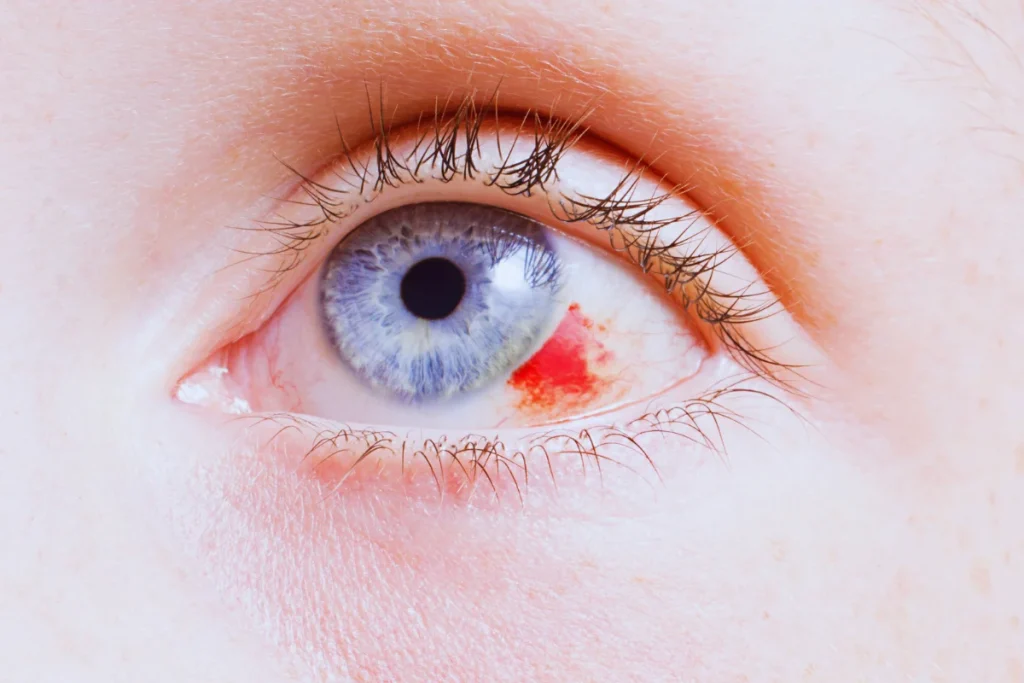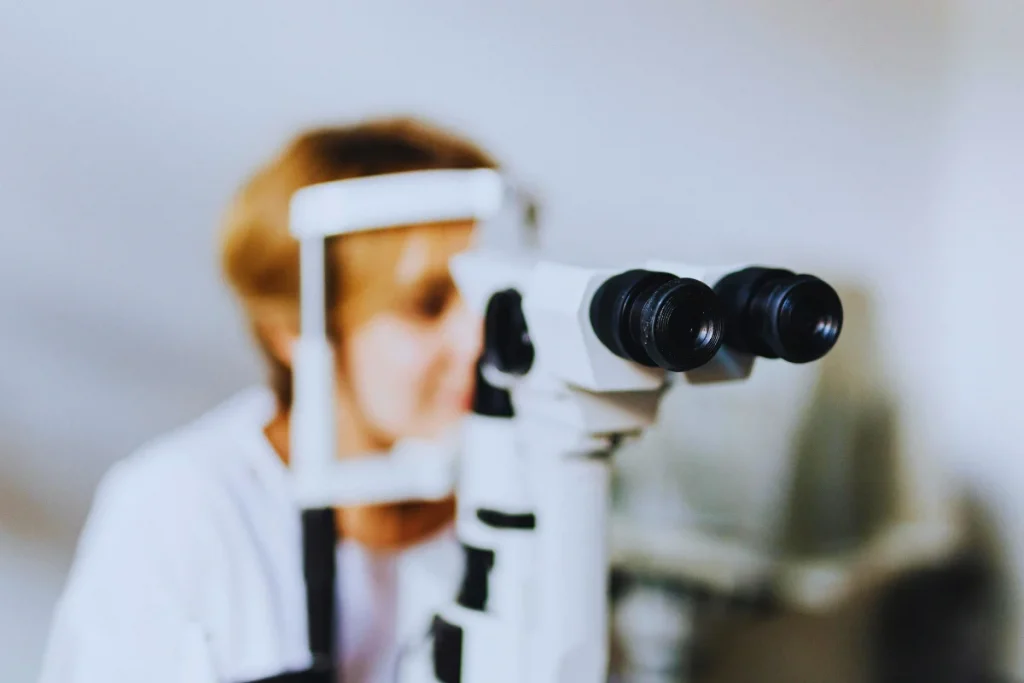Contact lenses have made vision correction easier and more convenient for millions of people. They offer clear sight without the need for bulky glasses and are great for sports, travel, or everyday life.
However, not everyone has a perfect experience with contacts. One of the most common problems people face is red eyes after wearing their lenses. This redness can be mild and temporary, or it can be a sign of something more serious.
If you’ve ever wondered, “Why does my eye turn red when I wear contacts?” you’re not alone. Redness can happen for many reasons, from dryness and allergies to infections or poor lens care. In this blog, we’ll explore the possible causes, symptoms to look out for, solutions to ease the discomfort, and when it’s time to consult an eye doctor.
Understanding the reason behind red eyes can help you protect your vision and wear your lenses more comfortably..
Is It Normal for Eyes to Turn Red When Wearing Contacts?
It’s not uncommon to notice a little redness in your eyes after wearing contact lenses, especially if you’ve had them in for a long day. Mild redness can simply mean that your eyes are tired, dry, or slightly irritated. This usually goes away after removing the lenses and giving your eyes some rest.
However, not all eye redness should be ignored. If your eyes stay red for several hours, feel sore, or become sensitive to light, it could be a sign of something more serious. Conditions like infections, allergic reactions, or poor oxygen flow to the cornea can cause more noticeable and lasting redness.
It’s important to know the difference. Temporary redness that fades quickly is usually nothing to worry about. But if it comes with pain, blurred vision, discharge, or swelling, you should take it seriously. These symptoms can indicate a bigger problem that may need medical attention.
In short, a little redness might be normal now and then, but ongoing or painful redness is your eye’s way of asking for help.
Common Causes of Eye Redness from Contact Lenses
If your eyes turn red while wearing contact lenses, it’s usually a sign that something isn’t quite right. Here are some of the most common causes:
Lack of oxygen (corneal hypoxia)
Contact lenses cover the cornea and can reduce the amount of oxygen that reaches your eyes. When this happens, blood vessels may expand to compensate, causing noticeable redness.

Dry eyes or reduced tear film
Wearing contacts can interfere with your tear film, especially if you already have dry eyes. Insufficient moisture can cause irritation, friction, and redness.
Poor lens hygiene or overuse
Not cleaning your lenses properly or wearing them beyond the recommended time can allow bacteria and debris to build up. This increases your risk of infections and inflammation.
Wearing damaged or expired lenses
A torn, scratched, or old contact lens can rub against your eye and damage the surface, leading to redness and discomfort.
Lens fit issues or foreign particles under the lens
If your lenses don’t fit well or if dust or debris gets trapped underneath, your eyes can become red and irritated very quickly.
Allergic reactions (to solution or lenses)
Some people are sensitive to certain contact lens cleaning solutions or the material of the lenses themselves. This can cause redness, itchiness, or even swelling.
Sleeping or napping in contacts
Unless your lenses are specifically made for overnight wear, sleeping in them can reduce oxygen flow and increase the risk of infection and redness.
Extended screen time or dry environments
Staring at screens or being in air-conditioned or windy environments can reduce your blink rate and moisture levels, leading to red, tired eyes while wearing contacts.
Understanding these triggers can help you make better choices and protect your eye health. Up next, we’ll look at the symptoms to watch for and what they might mean.
How to Treat Red Eyes from Contact Lenses
If your eyes become red while wearing contact lenses, the first and most important step is to remove your lenses immediately. Continuing to wear them can make the irritation worse and increase the risk of infection.

After removing your contacts, use preservative-free lubricating eye drops to soothe your eyes and add moisture. These drops help flush out any irritants and reduce discomfort. Make sure the drops are contact lens-safe if you plan to wear lenses again later.
To ease any swelling or irritation, you can also apply a cold compress to your closed eyelids for a few minutes. This can help calm inflammation and provide quick relief.
It’s best to avoid wearing contact lenses until the redness completely clears. Give your eyes time to rest and heal. Switching to your glasses during this time is a safe choice.
If you experience redness frequently, you might want to consider changing your contact lens brand or material. Some lenses offer better oxygen flow or moisture retention, which can be gentler on sensitive eyes.
Tips to Prevent Eye Redness When Wearing Contacts
Preventing eye redness starts with simple, consistent habits that protect your eyes from irritation and infection.
- Always wash your hands with soap and water before touching your contact lenses. This helps prevent bacteria and dirt from getting into your eyes.
- Follow the proper cleaning and storage instructions for your specific type of lenses. Using the wrong solution or skipping cleaning steps can lead to buildup and infections.
- Never sleep in your lenses unless your eye doctor specifically approves them for overnight wear. Closed eyes reduce oxygen to the cornea, increasing redness and dryness.
- Stick to the recommended wearing schedule. Overwearing contacts—even by a few hours—can cause dryness, fatigue, and redness.
- Stay hydrated and consider using a humidifier in dry indoor environments to help maintain your eye’s natural moisture.
- Give your eyes a break by switching to glasses occasionally. Letting your eyes rest from lens wear can prevent long-term irritation.
- Replace your lenses and storage case as recommended—usually every 1–3 months for cases and based on your lens type. Old lenses and cases can harbor harmful microorganisms.
By taking these preventive steps, you can enjoy the comfort and convenience of contact lenses without the discomfort of red, irritated eyes.
When to See an Eye Doctor
While occasional redness can be harmless, some cases need medical attention.
If your eye redness doesn’t improve after removing your contact lenses, it could be a sign of something more serious like an infection or corneal inflammation.
Seek immediate care if the redness is accompanied by pain, discharge, blurry vision, or sensitivity to light. These symptoms may point to conditions such as conjunctivitis, corneal ulcers, or uveitis, all of which require prompt treatment.
A history of eye infections or persistent irritation despite proper lens care also warrants a professional evaluation. Even if your lenses seem to fit well, your eyes may not be tolerating them properly.
If you notice frequent or regular redness, don’t ignore it. Your lenses might not be the right type or fit for your eyes. In that case, your eye care provider can perform a full exam, reassess your prescription, and suggest better lens options.
When in doubt, it’s always better to schedule a checkup. Eye redness shouldn’t be a regular part of wearing contacts and your optometrist can help keep your eyes healthy and comfortable.
Conclusion
Red eyes while wearing contacts can be caused by many things,from simple dryness to more serious conditions. Understanding the root cause and taking the right steps can protect your vision and comfort.
Always follow proper hygiene, avoid overwearing your lenses, and choose the right type of contacts for your eyes. Most importantly, listen to your body. If your eyes are red, itchy, or sore, it’s a sign to give them a break.
If your symptoms don’t improve or keep coming back, don’t hesitate to get expert advice.
If your red eyes persist, schedule an appointment with your eye care professional to find a solution that’s right for you.
FAQs
Can red eyes from contacts cause permanent damage?
In most cases, red eyes from contacts are temporary and harmless. However, if the redness is caused by an infection, corneal ulcer, or lack of oxygen over time, it can lead to serious complications, including vision loss. That’s why it’s important not to ignore symptoms that don’t go away.
Should I stop wearing contacts if my eyes are red?
Yes, you should remove your contacts immediately if your eyes are red. Continuing to wear them can make the irritation worse and delay healing. It’s better to switch to glasses until your eyes feel normal again.
How long should I wait before wearing contacts again?
Wait until all redness, discomfort, or other symptoms have completely gone. This could take a few hours or a few days depending on the cause. If in doubt, check with your eye doctor before using contacts again.
Are some lenses better for sensitive eyes?
Yes, there are lenses made from materials that allow more oxygen to reach your eyes and retain moisture better. Daily disposable lenses are also a good option since they reduce the chance of buildup and irritation.


